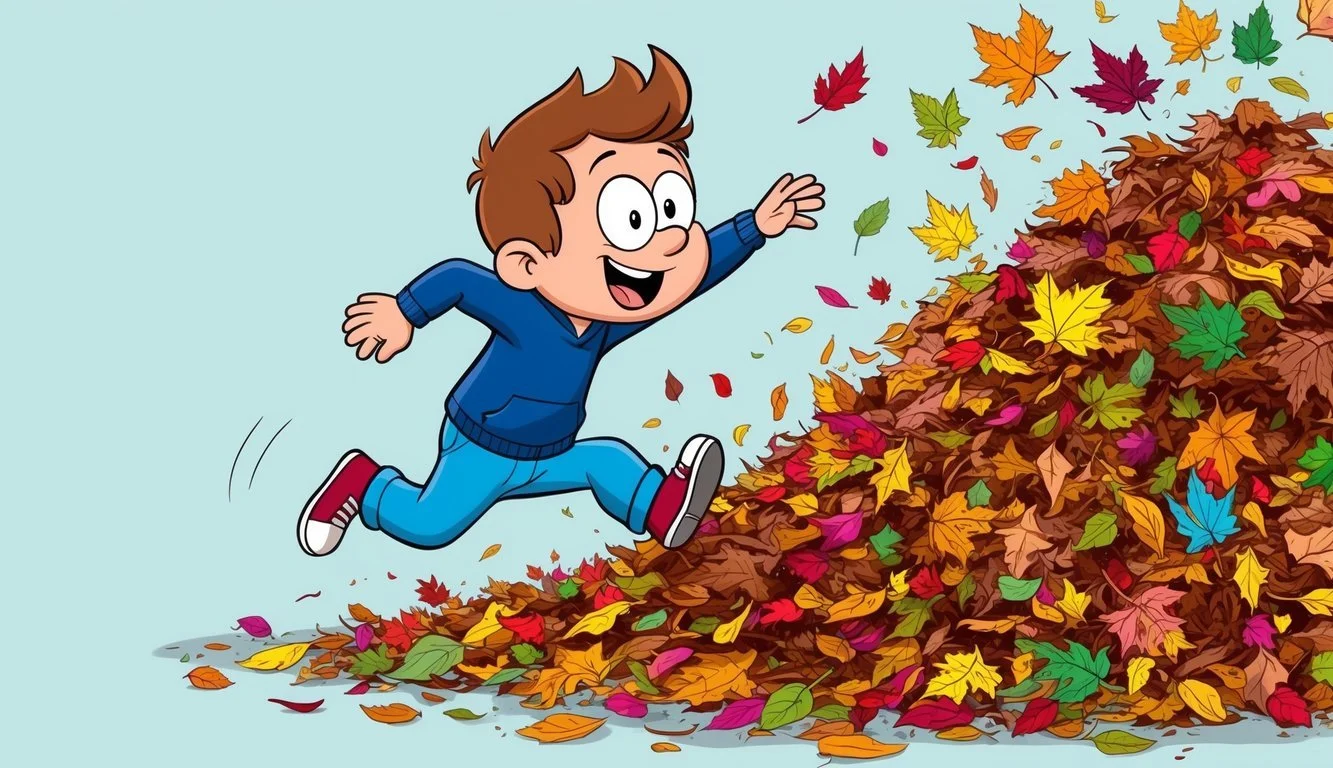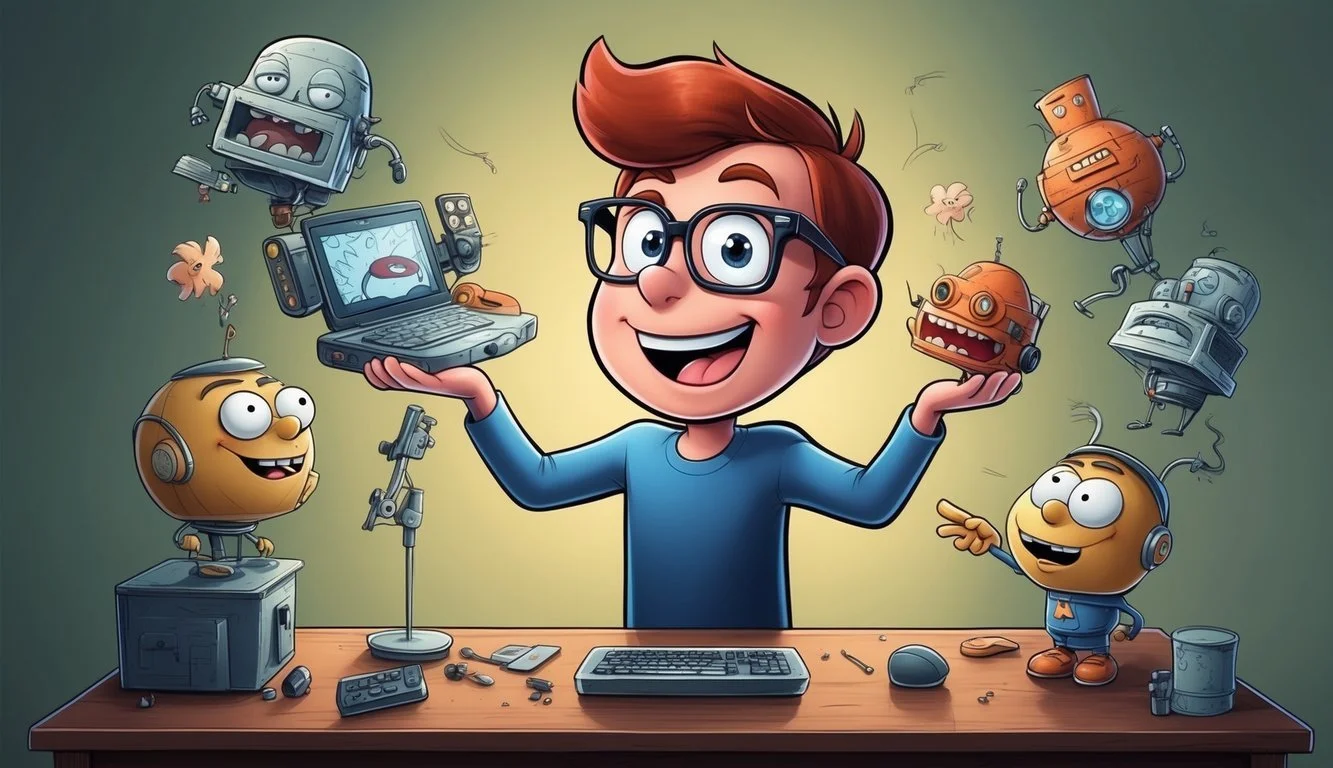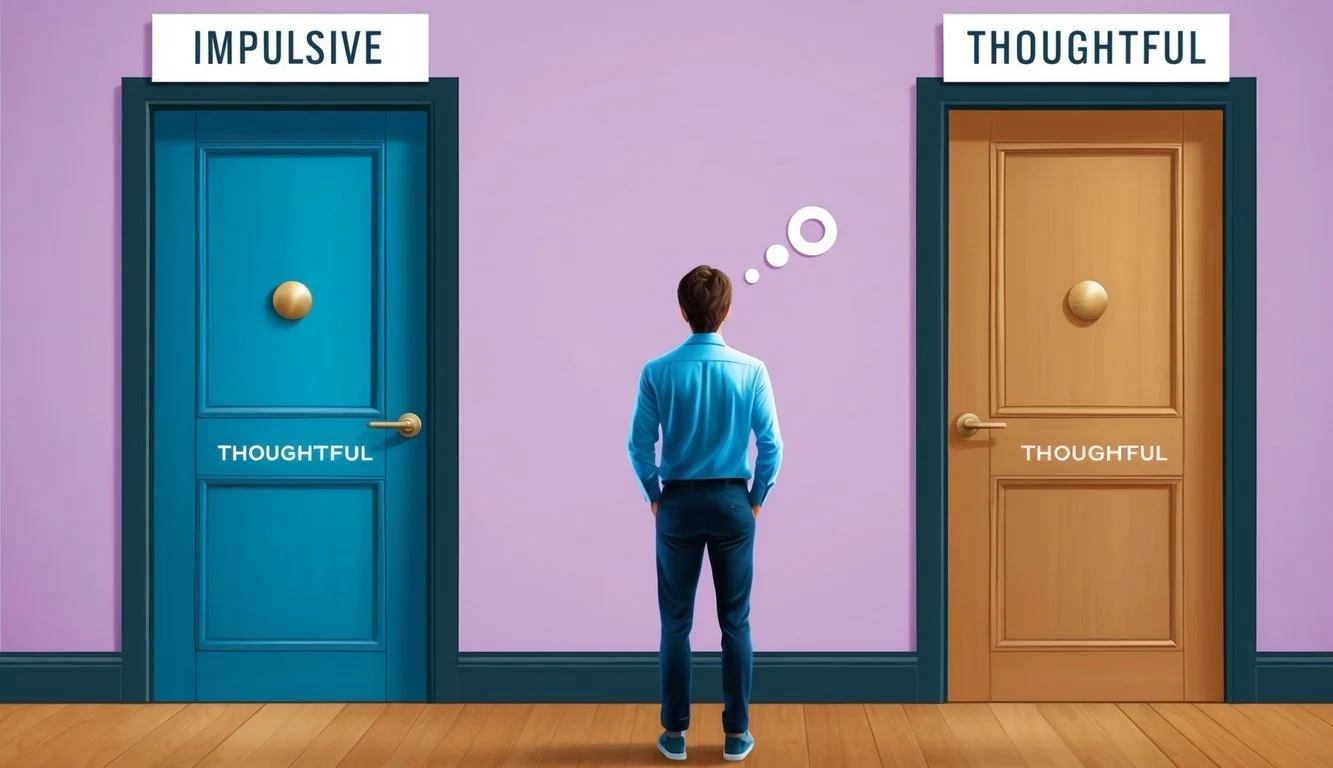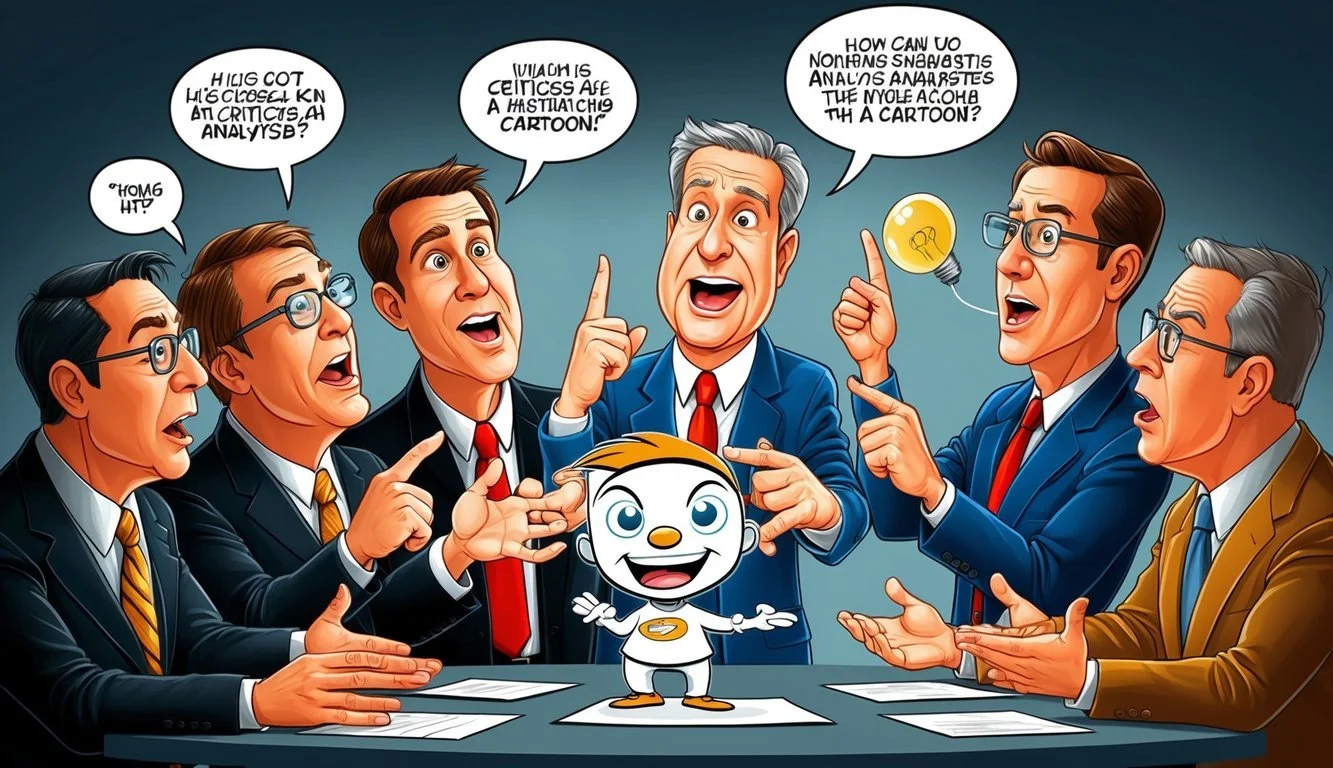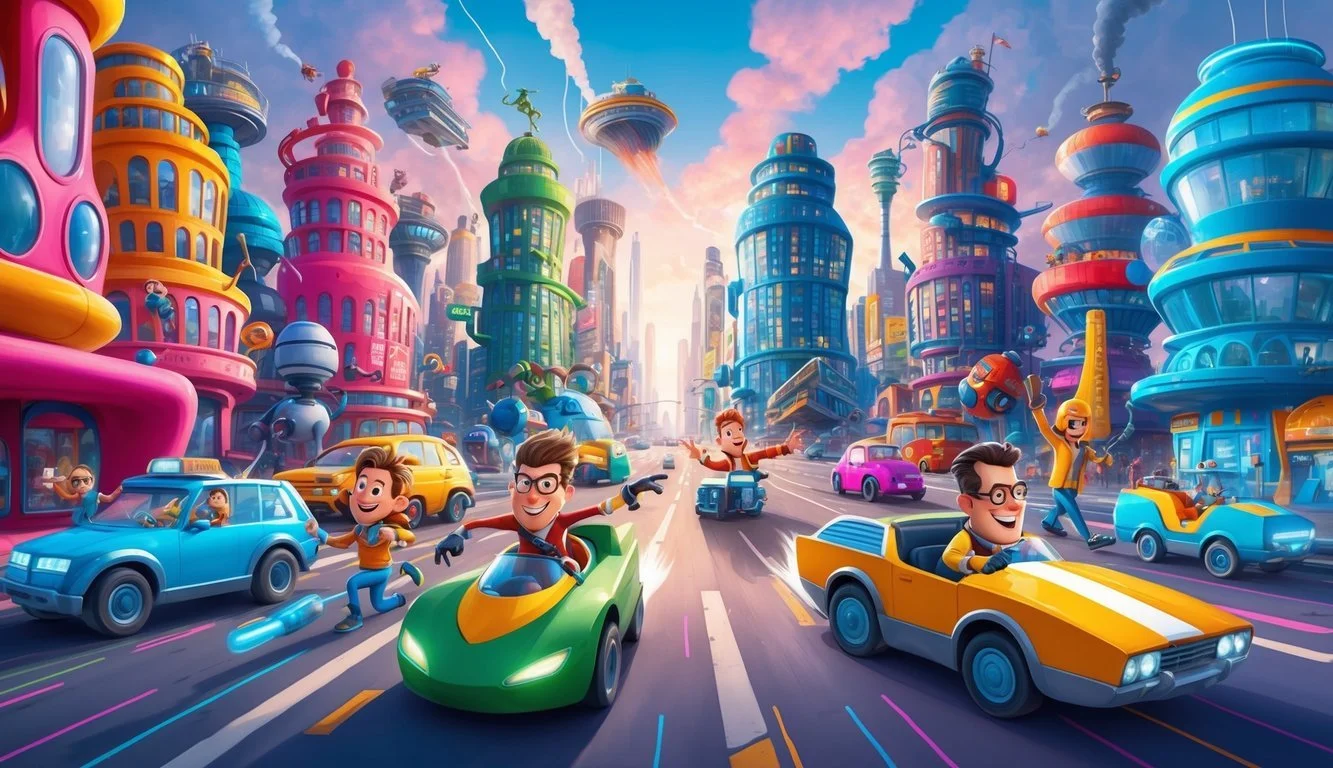Embrace the Laughs: Hilarious Impulsivity Cartoons That Reflect Our Quirky Choices
Impulsivity cartoons capture those spur-of-the-moment decisions and unexpected actions that often lead to hilarious situations. These humorous illustrations depict characters acting without forethought, providing a lighthearted look at human behavior. Cartoonists use impulsive characters to create comedic scenarios that resonate with viewers and reflect common experiences in an exaggerated form.
From spontaneous shopping sprees to last-minute adventures, impulsivity cartoons showcase a wide range of relatable moments. These cartoons often feature characters making snap decisions or reacting instinctively, resulting in amusing consequences. The visual medium allows artists to emphasize facial expressions and body language, enhancing the comedic impact of impulsive actions.
CartoonStock offers a diverse collection of impulsivity-themed cartoons, catering to various preferences and situations. These illustrations serve as a reminder to approach life with a sense of humor, even when faced with the results of our own impulsive choices. While the cartoons may exaggerate impulsive behavior for comedic effect, they also provide a gentle nudge to think twice before acting on sudden urges.
The Concept of Impulsivity
Impulsivity is a complex psychological trait characterized by quick, unplanned reactions without considering potential consequences. It involves spontaneous decision-making and a tendency to act on immediate urges.
Understanding Impulsivity
Impulsivity manifests as hasty actions without forethought. It can lead to both positive and negative outcomes. In some cases, impulsive behavior results in creative problem-solving or seizing opportunities. However, it may also cause reckless choices and regrettable actions.
Impulsive individuals often struggle with delayed gratification. They prefer immediate rewards over long-term benefits. This trait can affect various aspects of life, including relationships, finances, and career decisions.
Psychologists measure impulsivity through behavioral tasks and self-report questionnaires. These assessments evaluate factors like attention span, risk-taking tendencies, and ability to inhibit responses.
Psychological Perspectives
Different psychological theories offer varying explanations for impulsivity. Cognitive psychologists focus on information processing and decision-making mechanisms. They suggest impulsive behavior stems from deficits in executive functioning and self-control.
Behaviorists view impulsivity as a learned response reinforced by environmental factors. They emphasize the role of immediate rewards in shaping impulsive patterns.
Neuroscientists link impulsivity to brain structure and function. They identify areas like the prefrontal cortex and limbic system as key players in impulse control. Imbalances in neurotransmitters, particularly dopamine, may contribute to impulsive tendencies.
Causes and Factors
Impulsivity can be influenced by various factors:
Genetics: Research suggests a hereditary component to impulsive traits.
Brain chemistry: Neurotransmitter imbalances may affect impulse control.
Environmental factors: Upbringing, social influences, and life experiences shape impulsive tendencies.
Mental health conditions: ADHD, bipolar disorder, and substance abuse are associated with increased impulsivity.
Stress, fatigue, and emotional states can temporarily heighten impulsive behavior. Certain personality traits, like sensation-seeking, also correlate with higher impulsivity levels.
Age plays a role, with adolescents and young adults typically showing more impulsive tendencies. This is partly due to ongoing brain development in regions responsible for impulse control.
Impulsivity in Animation
Impulsivity plays a crucial role in animated characters and storylines. It adds spontaneity, humor, and sometimes conflict to the narrative. Animators harness impulsive behaviors to create memorable moments and drive plots forward.
Character Creation
Impulsive traits often define animated characters, making them relatable and entertaining. Animators use exaggerated facial expressions and quick movements to convey sudden decisions or actions. These impulsive characters might leap before looking or speak without thinking, leading to comedic situations.
Many beloved cartoon characters embody impulsivity. Examples include SpongeBob SquarePants, known for his enthusiasm and spontaneous actions, or Pinky from "Pinky and the Brain," whose random outbursts contrast with Brain's calculated plans.
Animators also use visual cues like thought bubbles or lightbulb moments to illustrate impulsive ideas forming in characters' minds. These techniques help viewers connect with characters and anticipate their unpredictable behavior.
Narrative Significance
Impulsivity serves as a powerful narrative tool in animation. It can kickstart adventures, create obstacles, or lead to unexpected resolutions. Impulsive decisions often act as plot catalysts, propelling stories in new directions and keeping audiences engaged.
In many animated films and series, impulsive actions lead to character growth. Characters learn from their hasty choices, developing self-control and wisdom over time. This character arc resonates with viewers, especially younger audiences learning about impulse control.
Impulsivity can also generate conflict between characters, driving interpersonal dynamics and plot development. The contrast between impulsive and cautious characters often creates tension and humor, enriching the storytelling experience.
Impulsive Characters in Cartoons
Cartoons often feature impulsive characters who act on sudden urges without considering consequences. These personalities drive humor and plot, resonating with audiences through their spontaneous actions and reactions.
Iconic Examples
Bugs Bunny stands out as a classic impulsive cartoon character. His quick-witted decisions and spur-of-the-moment pranks define his persona. Bugs often acts without hesitation, outsmarting his opponents with clever schemes.
SpongeBob SquarePants embodies childlike impulsivity. His enthusiasm leads to unpredictable behavior, frequently causing chaos in Bikini Bottom. SpongeBob's actions stem from pure excitement rather than malice.
Daffy Duck's impulsive nature manifests through his jealousy and desire for attention. He frequently makes rash choices in attempts to outshine others, particularly Bugs Bunny.
Character Analysis
Impulsive cartoon characters serve multiple narrative functions. They inject energy into storylines and create comedic moments through unexpected actions. These personalities often drive conflicts, pushing plots forward.
Writers use impulsivity to highlight character flaws and growth opportunities. As characters learn to control their impulses, they demonstrate personal development. This growth resonates with viewers, especially children learning self-control.
Impulsive traits in cartoons can reflect real-world behaviors.
Cartoons' Influence on Behavior
Cartoons significantly shape children's behavior and cognitive development. They serve as powerful tools for learning and socialization, impacting values, language skills, and problem-solving abilities.
Child Development Impact
Cartoon characters often become role models for young viewers. They can influence emotional and social growth by demonstrating various behaviors and reactions. Positive cartoon role models may encourage qualities like bravery, kindness, and empathy.
Some cartoons teach basic concepts like shapes, numbers, and colors in an engaging way. This interactive approach makes learning enjoyable for children. The simplified visual style of cartoons can help convey complex ideas and emotions in an accessible manner.
Cartoons can also affect attitudes and beliefs. Depending on the content, they may reinforce positive values or potentially promote undesirable behaviors. Parents and educators should be mindful of the cartoons children watch.
Educational Implications
Educational cartoons offer unique opportunities for learning. They can enhance language skills by exposing children to new vocabulary in context. Problem-solving abilities may improve as viewers follow characters working through challenges.
Cartoons are increasingly used as teaching tools in various subjects, including psychology. They can simplify difficult concepts and make them more relatable. This approach often leads to better retention of information.
The visual nature of cartoons supports different learning styles. They can be particularly helpful for visual learners. Some educational programs use cartoon characters to guide students through lessons, maintaining engagement and interest.
Animation Techniques and Impulsivity
Animating impulsive characters requires specific techniques to capture their spontaneous nature. Visual storytelling and precise motion and timing are crucial elements in bringing impulsive behaviors to life on screen.
Visual Storytelling
Impulsive characters often act without thinking, making their actions surprising and unpredictable. Animators use exaggerated facial expressions and body language to convey sudden mood shifts. Quick cuts between scenes can emphasize abrupt decisions.
Contrasting colors and dynamic compositions draw attention to impulsive moments. Animators might employ split-second flashes or distorted backgrounds to represent a character's internal state.
Sound effects and visual cues, like motion lines or impact stars, enhance the feeling of spontaneity. These elements work together to create a visual language that instantly communicates impulsivity to viewers.
Motion and Timing
Timing is critical when animating impulsive behaviors. Sudden accelerations followed by abrupt stops can effectively portray rash actions. Animators use anticipation sparingly, as impulsive characters often skip this step in real life.
Fast, erratic movements contrast with moments of stillness to highlight impulsive bursts of energy. Overshooting targets and bouncy follow-through animations emphasize a lack of control.
Animators carefully balance these rapid motions with slower, more deliberate movements of other characters or elements. This contrast helps underscore the impulsive nature of specific actions within the broader context of the scene.
Addressing Impulsivity
Effective strategies exist to manage impulsive behaviors and develop self-control. These approaches focus on both therapeutic interventions and preventive measures to help individuals gain better control over their impulses.
Therapeutic Approaches
Cognitive Behavioral Therapy (CBT) is a widely used treatment for impulsivity. It helps individuals identify thought patterns that lead to impulsive actions. Through CBT, patients learn to recognize triggers and develop coping mechanisms.
Mindfulness techniques teach awareness of present thoughts and feelings. This practice allows people to pause before acting on impulses. Regular meditation can improve impulse control over time.
Medication may be prescribed in some cases, particularly for conditions like ADHD. Stimulants or non-stimulant drugs can help regulate brain chemistry and reduce impulsive behaviors.
Preventive Strategies
Creating structured environments helps minimize impulsive decisions. This includes setting clear routines and organizing living spaces to reduce distractions.
Developing healthy habits is crucial. Regular exercise, proper sleep, and balanced nutrition contribute to better impulse control.
Using reminders and visual cues can prompt thoughtful decision-making. Sticky notes, phone alerts, or wearable devices serve as pauses before acting.
Planning ahead for challenging situations allows for prepared responses. This might involve role-playing scenarios or creating action plans for common triggers.
Building a support network of friends, family, or support groups provides accountability and encouragement in managing impulsivity.
Critical Reception and Analysis
Cartoons depicting impulsivity have garnered significant attention from media critics and researchers. Many analysts praise these cartoons for their ability to humorously illustrate complex psychological concepts.
Some experts argue that impulsivity cartoons can raise awareness about attention deficit disorders and other conditions associated with impulsive behavior. They suggest these visual representations make the topic more accessible to a general audience.
Critics have noted the potential for stereotyping or oversimplification in impulsivity cartoons. There are concerns that exaggerated portrayals could reinforce misconceptions about impulsive individuals.
A study published in the Journal of Media Psychology found that viewers exposed to impulsivity cartoons showed increased empathy towards people with impulse control issues. This suggests these cartoons may have positive educational value.
Content analysis of popular cartoons revealed varying degrees of accuracy in depicting impulsive behaviors. While some cartoons were praised for their realism, others were criticized for sensationalism.
Media literacy experts emphasize the importance of contextualizing impulsivity cartoons. They recommend using these visual aids as starting points for more in-depth discussions about impulse control and mental health.
Reception among mental health professionals has been mixed. Some appreciate the cartoons as tools for patient education, while others worry about potential trivialisation of serious conditions.
Cultural Representation of Impulsivity
Impulsivity is portrayed differently across cultures in media and entertainment. Cartoons often use exaggerated impulsive behaviors to create comedy and drive plotlines.
In Western animations, impulsive characters are frequently depicted as energetic, spontaneous, and sometimes reckless. They may act without thinking or struggle with self-control, leading to humorous situations.
Eastern animations like anime tend to represent impulsivity more nuanced. Characters might display sudden outbursts or make hasty decisions, but these traits are often balanced with deeper personality development.
Some common impulsive character archetypes in cartoons include:
The hyperactive sidekick
The rash hero
The unpredictable trickster
The easily distracted daydreamer
These portrayals can influence public perception of impulsivity. While entertaining, they may oversimplify complex behavioral traits.
Cultural values shape how impulsivity is viewed. Societies emphasizing self-control may portray it negatively, while those valuing spontaneity may present it more positively.
Representations of impulsivity in cartoons have evolved. Modern animations increasingly show nuanced characters, acknowledging both positive and negative aspects of impulsive traits.
Future Trends in Cartoon Portrayals
Minimalism is emerging as a key trend in cartoon illustration for 2025. Artists are embracing clean lines, simplified forms, and bold colors to create striking compositions. This style allows for impactful storytelling while appealing to modern audiences.
Hyperrealism is also gaining traction in cartoon features. Characters and environments are being rendered with increasing detail and lifelike qualities, blurring the line between animation and live-action.
AI-driven animation tools are revolutionizing the production process. These technologies enable faster creation of complex scenes and characters, opening up new possibilities for independent artists and small studios.
Interactive content is becoming more prevalent in cartoons. Viewers may soon be able to influence storylines or explore cartoon worlds in immersive ways through virtual and augmented reality experiences.
Diverse representation is a growing focus in cartoon portrayals. Characters of varied ethnicities, body types, and abilities are being featured more prominently to reflect real-world diversity.
Environmental themes are likely to play a larger role in cartoon narratives. Stories addressing climate change and sustainability may become more common as awareness of these issues grows.
Cross-platform storytelling is expanding. Cartoons are increasingly designed to span multiple media, from traditional TV to social media shorts and interactive apps.


